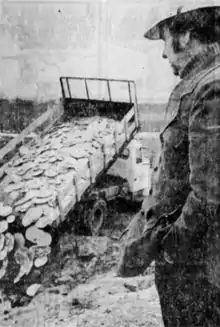Great Michigan Pizza Funeral
The March 5, 1973 Great Michigan Pizza Funeral (also referred to as the Great Pizza Funeral of Michigan and the Great Pizza Burial) was the ceremonial disposal of 29,188 frozen cheese and mushroom pizzas in Ossineke, Michigan.[1] The manufacturer, Mario Fabbrini, had been ordered to recall the pizzas by the Food and Drug Administration after initial tests suggested botulism was present in a batch of canned mushrooms. Fabbrini decided to ceremonially dispose of the pizzas to demonstrate accountability and receive publicity. The pizzas were tipped into an 18-foot (5.5 m) deep hole in the ground before a crowd of onlookers, who were addressed by Michigan governor William Milliken. Later tests by the FDA ruled out botulism. Fabbrini sued his suppliers and the Michigan Court of Appeals awarded him $211,000 in 1979, though he closed his business a few years later.

Background
Mario Fabbrini came from Fiume. Having endured fascist rule and then communist Yugoslavia after World War II he emigrated to the United States. Settling in Ossineke, Michigan he began making and selling frozen pizzas from his home kitchen.[2] Fabbrini's wife, Olga, helped him adapt the traditional recipes of his hometown to suit American tastes.[2][3] Within nine years Fabbrini had grown his business, Papa Fabbrini Pizzas, into one of the most modern pizza factories in the country.[1][2] His plant, which employed 22 people, had capacity to produce 45,000 pizzas a week.[2]
Alleged botulism contamination
In January 1973 employees at the United Canning Company of East Palestine, Ohio noticed a number of cans of mushrooms were swelling, an indication of contamination.[2][4][5] The plant had recently switched to an automated can-filling line which was less sterile than the previous method of hand-filling and also led to some overfilling of the cans. United Canning notified the Food and Drug Administration (FDA) who took samples for testing.[5]
The FDA stated that their tests confirmed the presence of botulism, a potentially fatal disease in humans.[5][1] The customers of United Canning were contacted by the FDA, including Tolono Pizza Products, a Chicago wholesaler who had sold the mushrooms to Fabbrini.[5] Fabbrini was himself contacted by the FDA on February 19, 1973 and told to recall his products.[2] Fabbrini estimated that 30,000 pizzas were involved, with a cost to him of $30,000 and a retail cost of around $60,000.[2][1] This was the largest recall of pizzas in American history at that time.[1] The FDA found no evidence of illness caused by Fabbrini's pizzas, although 17 claims were made by members of the public.[2]
Funeral

As a means of creating publicity and a demonstration of his accountability Fabbrini organized a public disposal of the recalled pizzas on March 5, 1973.[5][4] Fabbrini themed the occasion as a funeral and it was later referred to as Great Michigan Pizza Funeral", the "Great Pizza Funeral of Michigan" and the "Great Pizza Burial".[5][3][1] Several hundred people attended the event, at a time when Ossineke was a village of only 1,800 inhabitants.[1] The contemporary press reported that 40,000 or 44,000 pizzas were buried, though in later court documents Fabbrini claimed to have only disposed of 29,188.[5][1][6] The pizzas were tipped into an 18-foot (5.5 m) deep hole from four dump trucks.[1] The pizzas were still enclosed in their cellophane wrappers.[5]
After the burial Fabbrini laid a wreath of red gladioli and white carnations on the grave, which a report in Atlas Obscura claims represented the colours of pizza sauce and cheese.[7][4] The event was attended by Michigan governor William Milliken who gave a homily on the subject of courage in the face of tragedy.[5] Milliken was afterwards presented with a frozen pizza by Fabbrini, who also cooked pizzas on site to feed the attendees.[1] When one attendee questioned the safety of eating the food offered Fabbrini retorted "Gov. Milliken ate a piece and he's still alive".[7]
Aftermath
Although he stated he did not blame his suppliers and would continue to use them Fabbrini launched a $1 million lawsuit against United Canning and Tolono Pizza Products.[1][7] The case was finally settled in the Michigan Court of Appeals in 1979 with Fabbrini receiving $211,000.[5] Around a third of the award was needed to pay Fabbrini's legal costs.[3] In the early 1980s Papa Fabbrini Pizzas went out of business with Fabbrini selling its assets for $5,000.[3][5]
To complicate matters the initial FDA test results were overturned upon further investigation by the FDA and the Michigan state veterinarian. The deaths of the laboratory mice used in the deaths were confirmed to be from an unrelated peritonitis rather than botulism.[5]
The pizza funeral has been covered by modern publications including the website of The Paris Review, online magazine Atlas Obscura, the American magazine Saveur and the Canadian Pizza Magazine.[8][9][3]
References
- "Milliken Attends Pizza Burial". The South Bend Tribune. Newspapers.com. 6 March 1973.
- "Mushroom Scare Hits Pizza Shop". The Daily Courier. 72 (94). Newspapers.com. 2 March 1973. p. 9.
- Dao, Dan Q. (28 March 2017). "Why This Immigrant Entrepreneur Threw a Massive Pizza Funeral". Saveur. Retrieved 3 January 2021.
- Giaimo, Cara (14 March 2017). "The Day That Michigan Held a Funeral For 30,000 Pizzas". Atlas Obscura. Retrieved 3 January 2021.
- "Forty-five years ago this small Michigan town had a pizza funeral". Michigan Radio (28 February 2018). Retrieved 3 January 2021.
- "Pizza Served at Pizza Burial". Alexandria Daily Town Talk. 90 (354). Newspapers.com. 6 March 1973. p. 5.
- "'Funeral' marks mass burial of 44,000 pizzas". Battle Creek Enquirer. Newspapers.com. 6 March 1973. p. 11.
- Piepenbring, Dan (15 March 2017). "The Pizza Is Poisoned, and Other News". The Paris Review.
- "Pizza history: the massive Michigan pizza funeral that never had to happen". Canadian Pizza Magazine. 16 March 2017. Retrieved 3 January 2021.